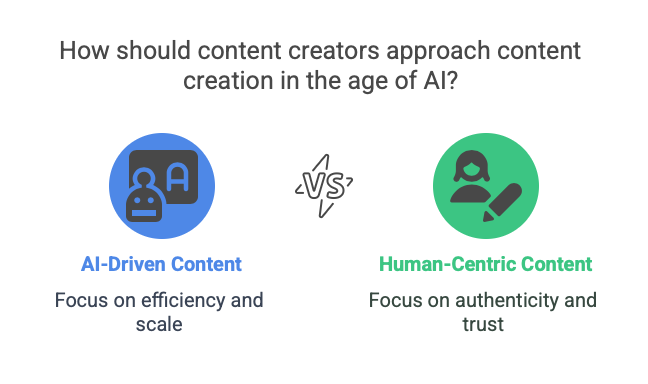
The digital landscape is buzzing with the capabilities of Artificial Intelligence (AI) writing tools. Platforms like ChatGPT, Bard, and specialized plugins such as BlogCopilot promise unprecedented efficiency, offering a tempting solution for generating blog posts, articles, and marketing copy at lightning speed. For busy small business owners (SBOs) struggling to find time for content creation and SEO professionals seeking streamlined workflows, these tools seem like a game-changer.
However, this technological leap coincides with Google’s intensified focus on content quality. The search giant is doubling down on rewarding content that is not just relevant, but also demonstrates high levels of E-E-A-T: Experience, Expertise, Authoritativeness, and Trustworthiness. Coupled with its Helpful Content System, Google aims to surface content created for people, offering genuine value and a satisfying user experience. The addition of “Experience” to the E-A-T framework in December 2022 underscores a deeper emphasis on authenticity and first-hand knowledge – qualities often challenging for AI to replicate genuinely.
This creates a fundamental tension: the push for AI-driven efficiency versus the critical need for human qualities like unique perspectives, deep understanding, and demonstrable credibility. While Google doesn’t automatically penalize content simply because AI was involved in its creation , it does reward high-quality, original, people-first content, regardless of its production method. Conversely, content generated primarily to manipulate search rankings, especially if it’s low-effort, unoriginal, or scaled without human oversight, risks violating spam policies and being devalued.
At the heart of this quality equation lies Trust. Google explicitly identifies Trustworthiness as the most crucial element of E-E-A-T. Without a foundation of trust, demonstrations of experience, expertise, or authority can crumble. This inherent connection between the rise of easily accessible AI content generation and Google’s heightened quality standards is not coincidental. As AI makes creating vast amounts of content easier , there’s a potential flood of generic, inaccurate, or low-value material hitting the web. This risks degrading the quality of search results and user satisfaction, which is paramount to Google’s success. Consequently, Google must continuously refine its ability to distinguish truly helpful, human-centric content from automated outputs lacking depth and reliability, using frameworks like E-E-A-T and the Helpful Content System as its guideposts.
This article serves as a guide for users of tools like BlogCopilot, including SBOs and SEO professionals, navigating this evolving landscape. It explores how to leverage AI as a powerful assistant while prioritizing and actively enhancing E-E-A-T to achieve sustainable success in search.
Deconstructing E-E-A-T: The Pillars of Quality Content
Understanding E-E-A-T is fundamental for anyone creating content intended to rank well and serve users effectively. It originates from Google’s Search Quality Rater Guidelines (QRG), a comprehensive document used to train human evaluators who assess the quality of search results. The feedback from these raters helps Google refine its ranking algorithms. While E-E-A-T itself isn’t listed as a direct, measurable ranking factor like page speed or keyword usage, the underlying principles it represents—credibility, reliability, user value—are absolutely what Google’s algorithms aim to identify and reward. Therefore, optimizing content and websites with E-E-A-T in mind inevitably leads to higher-quality assets that are more likely to perform well in search.
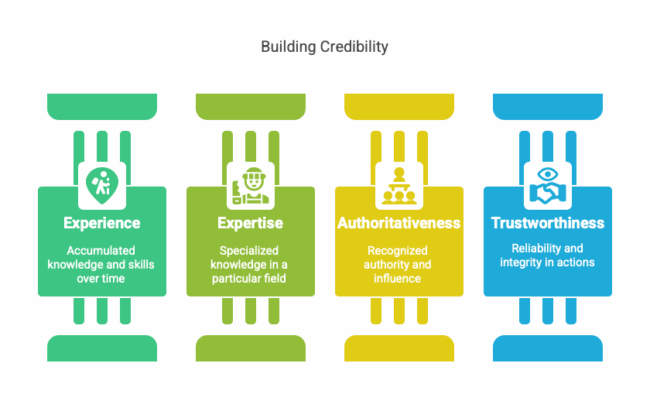
Let’s break down each component:
Experience (The First ‘E’)
Introduced in December 2022, the ‘Experience’ component emphasizes the value of content created by someone with demonstrable, first-hand, practical involvement with the topic. This means showing, not just telling, that the author has “walked the walk”.
- Why it Matters: Experience provides authenticity and unique insights that go beyond theoretical knowledge or summaries of existing information. Think about reading a review of a software plugin – wouldn’t the insights be more valuable from someone who has actually installed, configured, and used it extensively, compared to someone just summarizing the feature list? This is especially crucial for product reviews, travel guides, how-to tutorials, or sharing personal journeys (like financial management or health experiences) where lived experience adds significant credibility.
- Demonstrating Experience: Simply having the experience isn’t sufficient; it must be clearly conveyed within the content itself. This can be achieved through personal anecdotes, original photos or videos documenting the experience, specific details only obtainable through direct involvement, and sharing lessons learned.
Expertise (The Second ‘E’)
Expertise refers to the level of skill, knowledge, and formal qualifications the content creator possesses in their specific field. It addresses the creator’s capability and depth of understanding.
- Why it Matters: Expertise ensures the information provided is accurate, reliable, and comprehensive. This is particularly critical for “Your Money or Your Life” (YMYL) topics—those that could significantly impact a person’s health, financial stability, safety, or happiness (e.g., medical advice, financial planning, legal guidance, safety procedures). In these areas, misinformation can have serious consequences, so Google holds content to a higher standard of expertise.
- Demonstrating Expertise: This involves showcasing credentials (degrees, certifications), relevant professional experience, awards, and affiliations. It’s also demonstrated through the content itself—its depth, accuracy, clarity, and appropriate use of specialized terminology. Creating detailed author bios and dedicated author pages is a key tactic.
Authoritativeness (The ‘A’)
Authoritativeness is about the reputation and recognition of the content creator or the website as a whole. It signifies that others in the field view the source as influential and credible—a go-to resource for information on the topic.
- Why it Matters: Authority signals that the broader community within that niche respects the creator’s or website’s knowledge and influence. It’s often built through external validation signals that Google’s algorithms can interpret.
- Demonstrating Authoritativeness: This is typically earned over time. Key factors include acquiring high-quality backlinks from other reputable and relevant websites, positive mentions in the industry press or by other experts, strong brand recognition, and potentially maintaining a clear focus on a specific niche to become a known leader in that area.
Trustworthiness (The ‘T’)
Trustworthiness encompasses the accuracy, honesty, safety, transparency, and overall reliability of the content, the creator, and the website itself.
- Why it Matters: Google explicitly states that Trust is the most critical component of the E-E-A-T family. A website lacking trustworthiness will be considered low quality, regardless of how much experience, expertise, or authority it might otherwise seem to possess. Trust is fundamental for user confidence, encouraging engagement and interaction, and it’s absolutely essential for YMYL topics where users need to rely on the information presented.
- Demonstrating Trustworthiness: Trust is built through a combination of factors: ensuring factual accuracy and citing credible sources ; being transparent about authorship, the website’s purpose, and any potential conflicts of interest ; maintaining website security with HTTPS encryption ; providing clear and accessible contact information and customer support details ; cultivating a positive reputation through reviews and testimonials ; and ensuring content is up-to-date and policies are clear.
It’s crucial to recognize that E-E-A-T is not merely a collection of separate attributes but an interconnected system. Trust serves as the bedrock. Demonstrating genuine first-hand Experience makes claims more believable, thus enhancing Trustworthiness. Showcasing Expertise through verifiable credentials lends credibility to the information, bolstering Trust. Earning Authoritativeness through recognition and high-quality backlinks from respected sources acts as third-party validation, further reinforcing Trust. Conversely, a lack of transparency, such as hiding authorship or failing to secure the website, can severely damage Trust, negating any perceived Expertise or Experience. This interdependence means a holistic approach is necessary; focusing on just one element while neglecting others, especially Trust, is unlikely to satisfy Google’s quality expectations.
The AI Writing Paradox: Efficiency vs. Authenticity
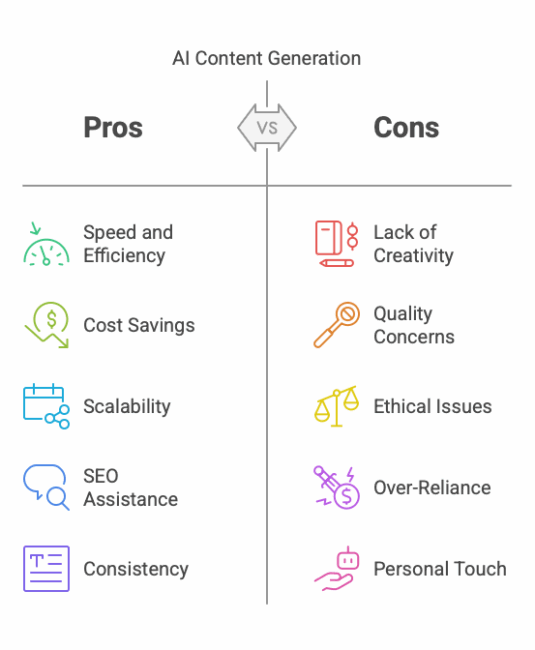 The rapid rise of AI writing tools presents a compelling proposition, particularly for resource-constrained SBOs and efficiency-driven SEO professionals. The benefits are undeniable and contribute significantly to their adoption:
The rapid rise of AI writing tools presents a compelling proposition, particularly for resource-constrained SBOs and efficiency-driven SEO professionals. The benefits are undeniable and contribute significantly to their adoption:
- Speed and Efficiency: AI can generate text almost instantaneously, drastically reducing content creation time and helping overcome writer’s block.
- Cost Savings: Compared to hiring professional writers, AI tools offer a significantly lower-cost alternative for producing content, especially at scale.
- Scalability: AI enables the production of large volumes of content quickly, potentially filling content calendars or supporting multiple websites.
- Basic SEO Assistance: Many tools can incorporate keywords, suggest outlines, and help with meta descriptions, offering a starting point for optimization.
- Consistency: AI can maintain a steady output without fatigue or variations in style (unless prompted otherwise).
However, these advantages come with significant drawbacks and risks, particularly when viewed through the lens of Google’s E-E-A-T and helpful content guidelines:
- Lack of Originality and Creativity: AI models learn by analyzing patterns in existing data. Consequently, their output often lacks genuine originality, unique insights, or a distinctive voice. Content can feel formulaic, generic, and fail to offer fresh perspectives. This can contribute to “thin content” issues, where the material adds little new value.
- Potential for Inaccuracies: AI systems can confidently generate incorrect information, fabricate sources (“hallucinations”), or rely on outdated training data. This necessitates rigorous human fact-checking for all AI-generated claims.
- Absence of True Experience and Emotion: AI cannot replicate genuine human experiences, personal anecdotes, nuanced emotions, or the tacit knowledge gained through years of practice. This is a direct challenge to demonstrating the ‘Experience’ component of E-E-A-T.
- Generic Tone and Lack of Voice: AI-generated text often sounds impersonal, robotic, or bland, failing to establish the human connection and personality that builds reader trust and engagement.
- Plagiarism and Copyright Concerns: Because AI learns from vast amounts of existing text, there’s a risk it might generate passages that are too similar to copyrighted sources, potentially leading to plagiarism issues.
- E-E-A-T Compliance Challenges: Without significant human intervention, AI struggles to authentically demonstrate Experience, deep Expertise (beyond summarizing known facts), and the signals of Trustworthiness (like transparency and genuine connection) that Google values.
Google’s perspective, particularly through its Helpful Content System (now integrated into its core ranking algorithms ), centers on rewarding content created for people, offering a satisfying and valuable experience, rather than content engineered primarily to rank in search results. The official stance isn’t anti-AI; it’s pro-quality. High-quality, original, people-first content can succeed regardless of how it was produced. Automation and AI have long generated helpful content like weather forecasts or sports scores without issue.
The critical distinction lies in intent and quality. Using AI as a tool to assist in creating helpful content is acceptable. However, using automation, including AI, primarily to manipulate search rankings by generating large amounts of low-quality, unoriginal, or unhelpful content is a violation of Google’s spam policies. Pages where “all or almost all” of the main content is AI-generated with “little or no effort, little or no originality, and little or no added value” risk receiving the lowest quality ratings. Similarly, simply paraphrasing existing content (whether by AI or manually) without adding substantial new value is also frowned upon.
This reveals the core of the paradox: the very mechanism that makes AI efficient—its ability to learn from and replicate patterns in existing human-generated content —is precisely what makes it inherently deficient in producing the unique, experience-driven, original, and deeply trustworthy signals that Google’s E-E-A-T framework and Helpful Content System increasingly prioritize. The efficiency gained through pattern replication comes at the potential cost of the authenticity and unique value Google seeks to reward. Therefore, relying solely on AI’s core function without significant human augmentation directly conflicts with Google’s evolving quality standards.
Harmonizing AI and E-E-A-T: The Human-AI Partnership
Navigating the AI writing paradox requires a strategic shift in perspective. Instead of viewing AI as a replacement author, it should be positioned as a powerful assistant or tool designed to augment human capabilities. Success lies in a collaborative partnership where humans provide the strategic direction, critical thinking, unique insights, and quality control, while AI handles specific, efficiency-boosting tasks.
Where AI Excels (The Assistant Role):
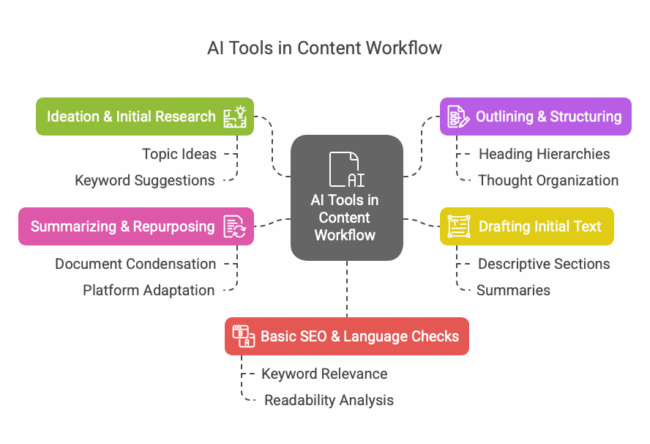 AI tools can significantly streamline various stages of the content workflow:
AI tools can significantly streamline various stages of the content workflow:
- Ideation & Initial Research: Generating topic ideas, suggesting related keywords, and identifying potential angles or sources (which always require human verification).
- Outlining & Structuring: Quickly creating initial content structures, suggesting logical heading hierarchies, and organizing thoughts.
- Drafting Initial Text: Generating first drafts rapidly, particularly useful for descriptive sections, summaries, or explaining well-established concepts.
- Summarizing & Repurposing: Condensing lengthy documents or reformatting existing content for different platforms or formats.
- Basic SEO & Language Checks: Suggesting relevant keywords, drafting initial meta descriptions, performing basic readability analysis, and checking for grammar and spelling errors.
Where Human Input is Irreplaceable (The Strategist & Expert Role):
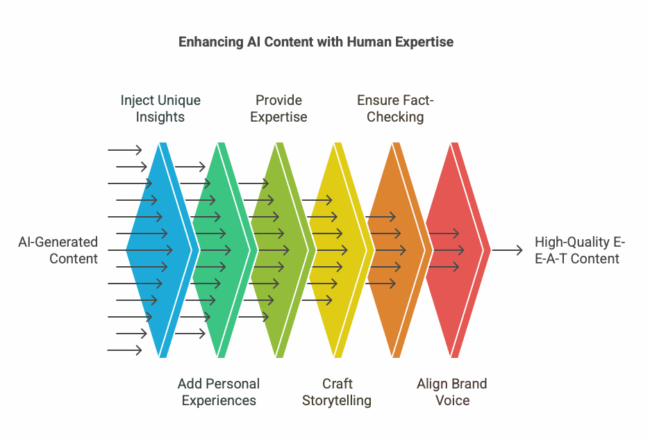 While AI assists with efficiency, human intelligence and experience are non-negotiable for achieving high E-E-A-T and creating truly valuable content:
While AI assists with efficiency, human intelligence and experience are non-negotiable for achieving high E-E-A-T and creating truly valuable content:
- Injecting Unique Insights & Analysis: Providing original perspectives, critical thinking, and analysis that goes beyond summarizing existing information. This is where true thought leadership emerges.
- Adding Personal Experiences & Anecdotes: Sharing genuine first-hand stories, specific case studies, real-world examples, and lessons learned directly addresses the ‘Experience’ requirement and builds authenticity.
- Providing Deep Subject Matter Expertise: Offering nuanced understanding, context, and advanced knowledge that AI, trained on general data, cannot replicate.
- Crafting Nuanced Storytelling & Emotional Connection: Using empathy, humor, brand personality, and engaging narratives to connect with the audience on a human level, fostering trust and relatability.
- Rigorous Fact-Checking & Source Validation: Meticulously verifying every claim made by the AI, ensuring all statistics are accurate and up-to-date, and confirming that cited sources are credible and correctly interpreted.
- Editing for Voice, Tone & Brand Alignment: Shaping the AI’s output to perfectly match the brand’s unique voice, style, and values, ensuring consistency and resonance with the target audience.
- Defining Strategic Direction & Purpose: Determining the ‘Who, How, and Why’ of the content – defining the audience, the creation process, and the ultimate goal – ensuring it aligns with business objectives and user needs.
- Ensuring Ethical Use & Transparency: Making informed decisions about disclosing AI involvement, preventing the spread of bias or misinformation, and avoiding deceptive practices like fake author profiles.
The following table summarizes the complementary roles in an E-E-A-T-focused workflow:
AI Assistant vs. Human Expert: Crafting E-E-A-T Content
| Task Category | AI Assistant Strengths | Irreplaceable Human Input | E-E-A-T Focus |
| Strategy & Intent | Suggesting related topics based on keywords | Defining target audience, content goals, unique angles, the “Why” behind the content | E, E, A, T |
| Research | Finding potential sources, keyword research, topic ideas | Validating source credibility, identifying truly authoritative sources, deep topic research | E, A, T |
| Outlining | Generating initial structure, suggesting headings | Ensuring logical flow, crafting a compelling narrative structure, prioritizing key points | E, E |
| Drafting | Creating first drafts quickly, summarizing information | Injecting personal experience/anecdotes, adding unique insights, expert analysis, storytelling | E, E |
| Fact-Checking | (Limited – can sometimes identify inconsistencies) | Verifying all claims, checking source accuracy, ensuring up-to-date information | T |
| Editing & Tone | Basic grammar/spelling, suggesting synonyms | Refining voice/tone, ensuring brand alignment, enhancing clarity, adding nuance/emotion | E, T |
| SEO Optimization | Suggesting keywords, basic meta tags, readability scores | Strategic keyword integration, optimizing for user intent, technical SEO beyond text | A, T |
| Author Credibility | (None) | Building author bios, showcasing credentials, establishing reputation, transparency | E, E, A, T |
| Ethical Oversight | (None) | Ensuring originality, avoiding bias, deciding on disclosure, final approval | T |
Effectively integrating AI requires more than just adding a tool to an existing process; it necessitates a workflow transformation. The human role shifts from laborious first-draft creation towards higher-value activities: strategic planning, deep research, injecting unique experience and expertise, rigorous verification, and ensuring brand alignment and ethical standards. Consider a revised workflow: the human defines the strategy and core message; AI assists with research, outlining, and drafting; the human then heavily edits and enriches this draft, infusing it with the critical E-E-A-T elements—personal stories, expert analysis, verified facts, unique voice—before final approval and publication. This approach leverages AI for efficiency while concentrating human effort on the elements that truly differentiate quality content and satisfy Google’s requirements. It’s a shift from “AI writes for me” to “I create high-quality content with AI’s assistance.”
Practical E-E-A-T Enhancement Tactics (Even with AI Assistance)
Demonstrating E-E-A-T isn’t just a theoretical concept; it requires concrete actions woven into content creation and website management. These tactics are essential whether content is primarily human-authored or benefits from AI assistance (always under human direction and scrutiny).
Demonstrate Experience (First ‘E’): Bring Content to Life
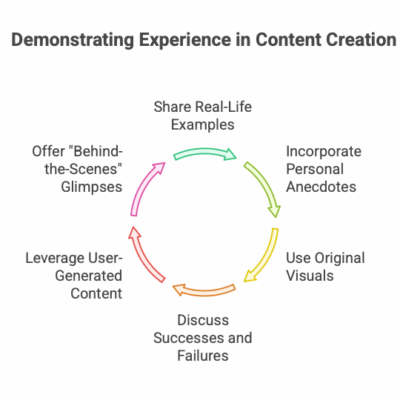 Share Real-Life Examples & Case Studies: Detail specific projects, client successes (with permission), or practical applications of concepts. Show, don’t just tell. AI cannot generate authentic, detailed case studies from scratch.
Share Real-Life Examples & Case Studies: Detail specific projects, client successes (with permission), or practical applications of concepts. Show, don’t just tell. AI cannot generate authentic, detailed case studies from scratch.- Incorporate Personal Anecdotes: Weave in relevant stories about personal challenges, discoveries, or journeys related to the topic. This builds connection and authenticity. AI lacks personal history.
- Use Original Visuals: Include unique photos or videos that document actual product use, event attendance, location visits, or process steps. Avoid relying solely on generic stock imagery.
- Discuss Successes and Failures: Transparency about what worked and what didn’t offers practical, relatable lessons and builds trust.
- Leverage User-Generated Content (UGC): Feature genuine customer reviews, photos, videos, or forum comments (with permission). This provides powerful social proof of real-world experience.
- Offer “Behind-the-Scenes” Glimpses: Show the human side of the brand – the workspace, the team, the creation process – to foster connection.
Showcase Expertise (Second ‘E’): Prove Knowledge and Skill
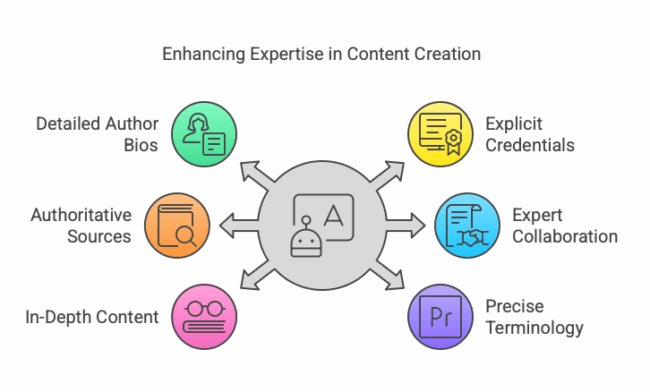 Implement Detailed Author Bios & Pages: This is crucial. Every piece of content should have a clear byline linked to a dedicated author page. These pages must detail the author’s credentials, relevant experience, education, awards, publications, and links to professional profiles (e.g., LinkedIn). This explicitly shows a real expert stands behind the content, vital if AI assisted in drafting. Absolutely avoid fake or AI-generated author profiles.
Implement Detailed Author Bios & Pages: This is crucial. Every piece of content should have a clear byline linked to a dedicated author page. These pages must detail the author’s credentials, relevant experience, education, awards, publications, and links to professional profiles (e.g., LinkedIn). This explicitly shows a real expert stands behind the content, vital if AI assisted in drafting. Absolutely avoid fake or AI-generated author profiles.- Explicitly List Credentials: Mention relevant degrees, certifications, years in the industry, or specific qualifications within the content or bio.
- Cite Authoritative External Sources: Back up claims with links to credible, recognized sources like peer-reviewed studies, government websites, established industry organizations, or publications from known experts. While AI can suggest sources, human verification of credibility is essential.
- Collaborate With or Interview Other Experts: Feature quotes, interviews, or contributions from other recognized figures in the field to add weight and diverse perspectives.
- Create In-Depth, Comprehensive Content: Aim for thorough coverage that addresses user needs comprehensively, demonstrating deep knowledge rather than just scratching the surface. Human expertise is required to add this depth beyond an AI-generated draft.
- Use Precise Terminology: Employ industry-specific language accurately and appropriately to signal familiarity and understanding.
Build Authoritativeness (‘A’): Earn Recognition and Reputation
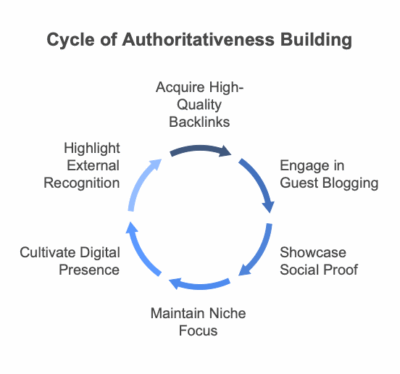 Acquire High-Quality Backlinks: Focus on earning links naturally from reputable, relevant websites within the industry. Create unique, valuable content (original research, data, tools, in-depth guides) that others will want to cite and link to.
Acquire High-Quality Backlinks: Focus on earning links naturally from reputable, relevant websites within the industry. Create unique, valuable content (original research, data, tools, in-depth guides) that others will want to cite and link to.- Engage in Guest Blogging: Contribute articles to other well-respected publications in the niche to build visibility and demonstrate authority to a wider audience.
- Showcase Social Proof: Prominently display positive customer testimonials, case study results, and reviews.
- Maintain a Clear Niche Focus: Develop deeper authority by concentrating efforts within a specific area of expertise rather than trying to cover too broad a range of topics.
- Cultivate a Strong Digital Presence: Build brand recognition through consistent quality content, active participation on relevant social media platforms, and engagement in industry conversations (e.g., speaking at events, appearing on podcasts).
- Highlight External Recognition: Display any media mentions, awards, or industry accolades received.
Establish Trustworthiness (‘T’): Secure the Foundation
- Prioritize Factual Accuracy: Implement rigorous fact-checking processes for all content, especially any text generated or assisted by AI. Verify statistics, claims, and dates. Clearly cite reliable sources.
- Practice Transparency: Be clear about authorship. Consider disclosing the use of AI in content creation where it might be expected or adds clarity. Avoid any misleading information about the website, its creators, or its purpose. Disclose affiliate links or potential conflicts of interest.
- Ensure Website Security: Use HTTPS (SSL certificate) across the entire site to encrypt data and protect users. This is a fundamental trust signal. Display security badges if relevant.
- Provide Clear Contact & About Information: Make it easy for users to find comprehensive information about the business or individual behind the site, including a physical address (if applicable), phone number, email, and potentially customer service details. A detailed ‘About Us’ page explaining the mission and team enhances trust.
- Keep Content Updated: Regularly review and refresh content to ensure information remains accurate, relevant, and current. Outdated information erodes trust. Fix broken links promptly.
- Maintain Professional Presentation: Ensure content is well-written, free from grammatical errors and typos, and uses clear, readable formatting (headings, subheadings, bullet points). A polished, user-friendly site experience builds confidence.
- Publish Clear Policies: Make Terms & Conditions, Privacy Policy, and any editorial guidelines easily accessible.
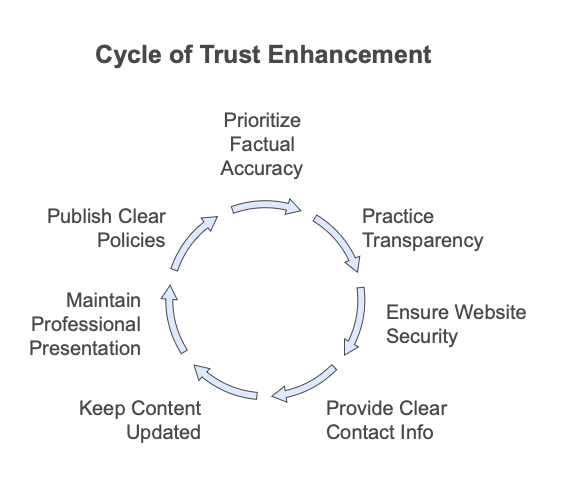 It’s important to recognize that fulfilling E-E-A-T requirements extends beyond the content itself. Many crucial signals are assessed at the author, site, or off-page level. AI writing tools primarily operate on the content level. While they might assist with on-page elements like keyword inclusion or basic structure , they cannot inherently build an author’s reputation, acquire high-quality backlinks, manage online reviews, or ensure website security. Therefore, users of tools like BlogCopilot must understand that AI content generation is just one component of a larger strategy. Success requires supplementing AI use with dedicated efforts in author branding, link building, reputation management, technical site health, and overall transparency to build a comprehensive E-E-A-T profile.
It’s important to recognize that fulfilling E-E-A-T requirements extends beyond the content itself. Many crucial signals are assessed at the author, site, or off-page level. AI writing tools primarily operate on the content level. While they might assist with on-page elements like keyword inclusion or basic structure , they cannot inherently build an author’s reputation, acquire high-quality backlinks, manage online reviews, or ensure website security. Therefore, users of tools like BlogCopilot must understand that AI content generation is just one component of a larger strategy. Success requires supplementing AI use with dedicated efforts in author branding, link building, reputation management, technical site health, and overall transparency to build a comprehensive E-E-A-T profile.
Conclusion: Augmenting Humans, Not Replacing Them
The emergence of sophisticated AI writing tools offers undeniable advantages in efficiency and scale for content creators. However, the path to sustainable success in Google Search doesn’t lie in replacing human insight with automation, but in strategically augmenting human capabilities. AI should be viewed as a powerful assistant—adept at research, outlining, and drafting—but requiring human guidance, expertise, and critical oversight.
Google’s continued emphasis on E-E-A-T, particularly the inclusion of ‘Experience’ and the principles of the Helpful Content System, signals a clear direction: prioritize content that offers genuine value, demonstrates credibility, and is created with the user’s needs foremost in mind. Low-effort, unoriginal, or inaccurate content, regardless of whether it was generated by AI or humans, is unlikely to perform well in the long run.
Ultimately, the goals of the user searching for information and the goals of Google providing relevant results are aligned. Users seek trustworthy answers and solutions from credible sources. They naturally gravitate towards content demonstrating experience, expertise, and authority, presented on a secure and transparent platform. Google aims to deliver exactly that kind of content to maintain user satisfaction. Therefore, focusing on building genuine E-E-A-T and creating truly helpful, people-first content isn’t just about appeasing an algorithm; it’s about fundamentally serving the audience well.
For users of tools like BlogCopilot, the key is to embrace a human-AI partnership. Leverage AI for efficiency gains, freeing up valuable time to invest in the irreplaceable human elements: injecting unique experiences, providing deep expert analysis, ensuring factual accuracy, cultivating an authentic brand voice, and building overall trust. By prioritizing genuine value and demonstrating strong E-E-A-T, SBOs and SEO professionals can navigate the age of AI responsibly and build a foundation for lasting success in search. Focus on building trust and providing real help – the rankings are likely to follow.
